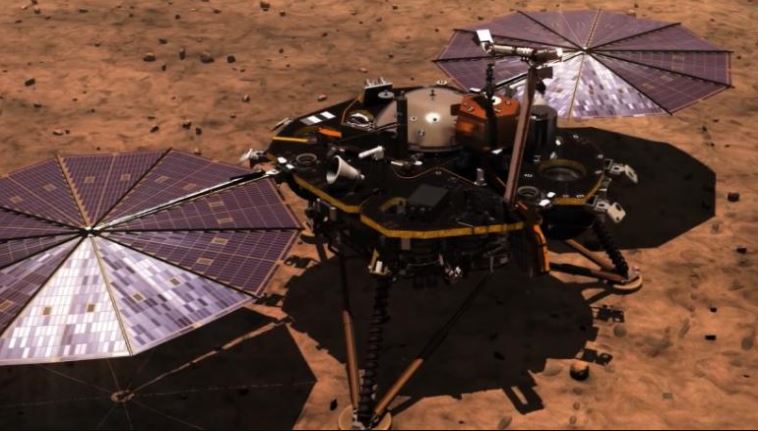Most Recent News
Breakthrough in Mars Mission: NASA has successfully landed InSight Robot on planet Mars
-
 Chris Yahaya
Chris Yahaya
- November 29, 2018, 12:32 pm
 Hello followers of Weather Report of the Department of Geography, Federal University Lokoja, if you could remember on the 28th June, we reported that planet Mars was closest to Earth and we promised to bring updates on the “Next Inhabitable Planet” as Mars is fondly called by Geographers. We are happy to give you update on the scientific breakthrough by NASA as it landed its robot InSight on the surface of Mars.
Hello followers of Weather Report of the Department of Geography, Federal University Lokoja, if you could remember on the 28th June, we reported that planet Mars was closest to Earth and we promised to bring updates on the “Next Inhabitable Planet” as Mars is fondly called by Geographers. We are happy to give you update on the scientific breakthrough by NASA as it landed its robot InSight on the surface of Mars.
THE MISSION
AIM:
The InSight probe mission aimed to study the interior of Mars, which if successful will make Mars the second planet after Earth, whose interior, geology and geomorphology, is now studied with precision and concise data.
LANDING:
InSight landed on the surface of Mars after a dramatic seven-minute plunge through the atmosphere of the planet. Confirmation of the touchdown reached Earth at exactly 19:53 GMT of Monday 26th November (8:53 pm, Local Time in Nigeria). Message of its landing was received at NASA’s Mission Control Centre at the California’s Jet Propulsion Laboratory (JPL).
LOCATION:
InSight is currently located on a vast, flat plain close to Mars’ Equator which has already been named Elysium Planitia.
EXPECTED ACTIVITIES:
- The first activity of the robot InSight on Mars is to deploy its Solar Panels. These panels would be used to generate electricity which is required to power the operation of its systems and to warm its equipment at the sub-zero Mars temperature. Notification of the successful set up of the panels reached Earth seven hours after its landing.
- Observations of Marsquakes (as opposed to Earthquakes on Earth) using a Franco-British seismograph carrying various seismometers. Vibrations of Marsquakes as received by the seismograph will reveal the position of Mars’ bedrocks, their layers and compositions.
- A 5m pit will be dug into the ground using a German-led ‘mole’ system which will take the interior temperature of Mars. This will also reveal how active the planet is.
- To determine with precision Mars’ wobbling on its axis using American Radio Transmission Technology. This will most accurately determine whether the interior of Mars is liquid or solid and will give an idea on the size and chemistry of its core.
SPECTACULAR EVENTS DURING THE MISSION:
- The Landing: InSight entered Mars’ atmosphere in a spectacular way. The speed of entry was faster than that of a high-velocity bullet. To be able to terminate this speed for a successful landing, InSight uses a combination of a heat shield parachute and rockets to bring itself to a safe landing.
- The activities of MarCO A and MarCO B: These are mini-spacecraft satellites which followd InSight to the Mars mission. All radio signals from the mission were transmitted through the duo satellites MarCO A and MarCO B. The satellites spectacularly sent a photo message automatically showing a picture of Mars. The Entry, Descend and Landing (EDL) was also reported meter by meter by MarCO A and B simultaneously.
- Dust rise during landing: Spectacularly, great dust rise as InSight landed on Mars’ surface blurring the images taken by its cameras, but gravity settled the dust at almost thrice slower the pace of Earth’s gravity. A stone was captured after the dust settled.
SOME NOTABLE SCIENTIST IN THE MISSION:
- Tom Hoffman - Project Manager
- Bruce Banerdt - Principal Investigator
- Suzanne Smreker - Deputy Principal Investigator
- Matt Colombek - Landing Site Lead
- Jason Willis - Project System Engineer
- Linda Facto - Safety and Mission Assurance Manager
- Charles Scott - Flight Systems Manager
- Stuart Spath - Spacecraft Manager
- Pauline Hwang - Mission Operations System Engineer
- Tiffany Daleo - Business Manager
- Rick Welch: Mission Manager
- Ramon DePaula: Program executive
- Richard Turner: Program Manager
- Robert Fogel: Program Scientist
For further enquiries, contact the Department of Geography, Federal University Lokoja.
Latest News
-
CSR: FUL Music Department Students Wow Governor Usman Ododo as Management Presents First Ever Kogi Anthem to State Government
July 17, 2024, 7:30 pm -
Power Generation: FUL Partners US-Based Company to Generate Electricity from Waste
July 17, 2024, 5:28 pm -
Groundbreaking Ceremony of Engr. Dr. Joseph Oyeyani Makoju Memorial Hall at FUL
July 13, 2024, 2:30 pm -
FUL Management Holds Familiarization Meeting with New Governing Council Amidst High Expectations
July 12, 2024, 10:20 pm -
CIPM Kogi State Branch Seeks Collaboration with FUL Registrar, Dr. Rebecca Okojie
July 12, 2024, 1:30 pm -
Groundbreaking Ceremony of Engr. Joseph Oyeyani Makoju Memorial Hall at Federal University Lokoja
July 12, 2024, 8:30 am -
FUL VC Lauds Senator Natasha's People-oriented Programmes as Lawmaker Pledges Support for Kogi Varsity
July 11, 2024, 10:34 pm -
Notice of FUL 20th Inaugural Lecture to be Delivered by Professor David Kolawole Omole
July 11, 2024, 4:12 pm